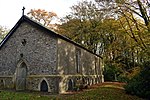Hembury
Archaeological sites in DevonCausewayed enclosuresHill forts in DevonHills of DevonHistory of Devon ... and 2 more
Iron Age sites in EnglandRoman fortifications in Devon

Hembury is a Neolithic causewayed enclosure and Iron Age hillfort near Honiton in Devon. Its history stretches from the late fifth and early fourth millennia BC to the Roman invasion. The fort is situated on a south facing promontory at the end of a 240m high ridge in the Blackdown Hills. It lies to the north of and overlooking the River Otter valley and this location was probably chosen to give good views of the surrounding countryside as well as for defensive reasons. The Devon Archaeological Society bought the hillfort in 2022.
Excerpt from the Wikipedia article Hembury (License: CC BY-SA 3.0, Authors, Images).Hembury
A373, East Devon Payhembury
Geographical coordinates (GPS) Address Nearby Places Show on map
Geographical coordinates (GPS)
| Latitude | Longitude |
|---|---|
| N 50.820555555556 ° | E -3.2613888888889 ° |
Address
A373
EX14 3LA East Devon, Payhembury
England, United Kingdom
Open on Google Maps









